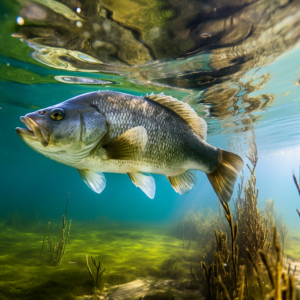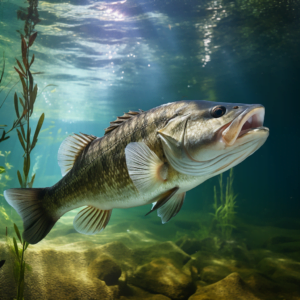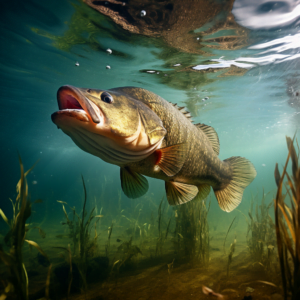So, have you ever wondered what bass do in falling water? You know, when it’s raining and the water is gushing down the streams and rivers? Well, let me tell you, bass play quite an important role in this natural phenomenon. You see, bass are not just your ordinary fish, they are known for their unique adaptations and behavior that enable them to thrive in swiftly moving waters.
First of all, bass are quite the agile swimmers. They have a streamlined body and powerful tails, which allows them to navigate through the fast currents with ease. This is especially important when it comes to falling water, as the increased flow and turbulence can make it quite challenging for other fish species to swim against the current. But not bass, they’re like the Michael Phelps of the fish world!
Another interesting thing about bass is their feeding habits in falling water. They are opportunistic predators, meaning they take advantage of the increased flow of water to ambush their prey. The bass will position themselves near rocks, fallen trees, or any other structure that creates a break in the current, and wait patiently for unsuspecting smaller fish or insects to get swept away. And when the perfect moment comes, they strike! It’s like a game of cat and mouse, but in this case, it’s fish and prey.
If you’re interested in learning more about the fascinating role of bass in falling water, make sure to check out the rest of the article. You’ll discover how they adapt to changing conditions, their importance in the ecosystem, and how anglers can take advantage of their behavior to catch some impressive catches. Trust me, you won’t be disappointed!
| Bass Species | Max Size (inches) | Preferred Habitat | Feeding Habit | Common Prey in Falling Water | Spawning Month |
|---|---|---|---|---|---|
| Largemouth Bass | 29.5 | Shallow, vegetated areas | Opportunistic | Small fish, insects | April – June |
| Smallmouth Bass | 27 | Rocky substrates, clear water | Opportunistic | Crayfish, minnows | May – June |
| Spotted Bass | 24 | Clear, slow-moving water | Opportunistic | Insects, small fish | April – May |
Introduction
Bass, a popular freshwater fish species, play a vital role in ecosystems with falling water. Their behavior, reproduction, and interactions with other species are greatly influenced by the presence of falling water. In this article, we will explore the various aspects of bass in falling water ecosystems, including their definition, physical characteristics, impact on the ecosystem, challenges they face, fishing techniques, conservation efforts, and recent research findings.
Definition of Bass
Bass refers to a genus of fish belonging to the family Centrarchidae. This family includes several species, such as largemouth bass, smallmouth bass, and spotted bass. These species are known for their large mouths, strong swim bladders, and powerful tails. Bass are highly sought after by anglers due to their aggressive feeding behaviors and challenging fights when hooked.
Different types of bass
There are several different types of bass that can be found in falling water ecosystems. The largemouth bass, Micropterus salmoides, is one of the most prevalent species. It has a dark green coloration with a white belly and can grow to impressive sizes. The smallmouth bass, Micropterus dolomieu, is another common species and is known for its bronze-colored body and vertical striping. The spotted bass, Micropterus punctulatus, is smaller in size compared to largemouth and smallmouth bass but can still be found in falling water environments.
Physical characteristics of bass
Bass have several physical characteristics that allow them to thrive in falling water ecosystems. Their large mouths are perfectly adapted for capturing prey, while their strong swim bladders help them control buoyancy and adjust to changing water levels. Bass also have a powerful tail fin, which enables them to navigate swiftly in turbulent currents.
Falling Water and Its Impact on Bass
How falling water affects bass behavior
Falling water has a significant impact on the behavior of bass. As water levels decrease, bass tend to become more active and move closer to shorelines or other areas with cover and structure. The turbulence caused by falling water creates ideal conditions for bass to search for food and ambush unsuspecting prey. Bass exhibit heightened feeding activity during falling water events, making it an opportune time for anglers to target them.
Reasons behind bass response to falling water
The response of bass to falling water can be attributed to several factors. Firstly, the increased water movement stirs up the environment, disorienting small fish and other prey species. This makes it easier for bass to locate and capture their meals. Secondly, the falling water often brings a fresh influx of food and nutrients into the ecosystem, attracting baitfish and other organisms that bass feed on. Lastly, the changing water levels prompt bass to explore new areas and adapt to the dynamic conditions, leading to increased activity and feeding.
Role of Bass in Ecosystems with Falling Water
Bass as a predator in falling water ecosystems
Bass play a crucial role as predators in falling water ecosystems. They occupy a position in the food chain where they regulate the populations of smaller fish and invertebrates. By preying on these organisms, bass maintain a balance within the ecosystem and prevent the overabundance of certain species. Moreover, their predatory behavior helps to control the spread of diseases and parasites among other aquatic organisms, thereby contributing to the overall health of the ecosystem.
Bass’s impact on other species in falling water ecosystems
In addition to their role as predators, bass also influence the behavior and populations of other species in falling water ecosystems. Their presence can alter the distribution and movement patterns of smaller fish, as these prey species actively avoid areas where bass are known to inhabit. Bass also serve as indicators of ecosystem health, as their abundance and condition can provide valuable insights into the overall condition of the water body and the availability of resources for other organisms.
Bass Reproduction and Falling Water
Bass spawning behavior in falling water
Falling water events have a significant impact on the reproductive behavior of bass. Largemouth bass, for example, prefer to spawn in shallow water with vegetation, such as submerged grass or lily pads. When falling water occurs, it can create the ideal conditions for bass to spawn, as the receding water levels expose shallow areas that were previously inaccessible. Bass use these shallow waters to build nests or beds where the eggs are laid and subsequently guarded by the male bass until they hatch. The falling water can thus trigger the spawning process and lead to successful reproduction.
Effects of falling water on bass reproductive success
While falling water can promote spawning for bass, it can also have adverse effects on their reproductive success. Rapidly changing water levels and increased turbidity can wash away or disturb the bass nests, potentially exposing the eggs to unfavorable conditions or predation. Additionally, drastic fluctuations in water temperatures and oxygen levels, which often occur during falling water events, can impact the survival and development of the eggs. These factors highlight the delicate balance between falling water and bass reproductive success.
Challenges Faced by Bass in Falling Water
Strategies bass use to navigate turbulent water
Bass have evolved several strategies to navigate turbulent water conditions. They are highly agile swimmers and possess excellent control over their movements, allowing them to maneuver through rapid currents and changing water levels. Bass often utilize structures such as submerged vegetation, fallen trees, or rocks as cover and shelter from strong water currents. They also have a keen ability to sense changes in water pressure, enabling them to adjust their swimming pattern and position within the water column.
Effects of rapidly changing water levels on bass
Rapidly changing water levels pose challenges for bass in falling water ecosystems. Sudden decreases in water depth can restrict their access to preferred habitats and force them to relocate or adapt to new areas. The loss of established territories and the need to compete for limited resources can lead to increased competition and potential conflicts among bass. Furthermore, the increased turbulence and reduced visibility caused by falling water can make it more difficult for bass to locate and capture prey, which may impact their feeding efficiency.
Bass Fishing in Falling Water
Techniques for fishing bass in falling water
Falling water events provide excellent opportunities for bass fishing. One effective technique is to target bass near cover, such as submerged vegetation, fallen trees, or rocks, as they seek shelter from the increased water movement. Using lures that imitate injured or vulnerable prey, such as crankbaits or spinnerbaits, can attract attention from bass looking for an easy meal. Another effective technique is to use topwater lures during low-light conditions or when bass are actively feeding near the water’s surface. These techniques capitalize on the bass’s heightened activity and predatory behavior during falling water events.
Best baits and lures for bass in falling water
When fishing for bass in falling water, it is important to choose baits and lures that mimic the prey species commonly found in the ecosystem. Soft plastic worms, jerkbaits, and jigs are popular choices, as they can be presented in a lifelike manner and entice strikes from bass. Crankbaits and spinnerbaits are also effective, especially when retrieved at varying speeds to imitate injured baitfish. It is essential to experiment with different colors, sizes, and retrieval techniques to find the combination that works best for the specific falling water conditions and the preferences of the bass in that ecosystem.
Conservation Efforts for Bass in Falling Water
Importance of conserving bass populations in falling water ecosystems
Conserving bass populations in falling water ecosystems is of utmost importance. Bass serve as indicators of ecosystem health and vitality, and their presence is crucial for maintaining a balanced and resilient aquatic community. Additionally, bass fishing is a popular recreational activity that contributes significantly to local economies. By protecting bass populations and their habitats, we can ensure the sustainability of both the ecosystem and the recreational fishing industry.
Fishing regulations and practices to protect bass
To protect bass populations, fishing regulations and practices are essential. These regulations often include catch limits, size restrictions, and seasonal closures during critical spawning periods to allow bass to reproduce successfully. Additionally, practicing catch-and-release fishing can help maintain healthy bass populations by allowing individuals to grow and reproduce. It is crucial for anglers to be aware of and adhere to these regulations to ensure the long-term conservation of bass in falling water ecosystems.
Research and Studies on Bass in Falling Water
Recent findings on bass behavior in falling water
Recent research has provided valuable insights into bass behavior in falling water ecosystems. Studies have shown that bass exhibit increased movement and feeding activity during falling water events and tend to concentrate in specific areas with favorable conditions. Advanced tracking technologies, such as acoustic telemetry, have allowed researchers to monitor the movement patterns and habitat preferences of bass during falling water events in real-time. These findings contribute to our understanding of bass behavior and aid in the development of effective conservation and management strategies.
Advancements in understanding bass ecology in falling water ecosystems
Advancements in technology and research methods have led to a better understanding of the ecology of bass in falling water ecosystems. Researchers now have the tools to study the interactions between bass and their environment in unprecedented detail. For instance, hydroacoustic imaging allows scientists to map the distribution and abundance of bass in falling water habitats. Genetic studies have also provided insights into the population structure and connectivity of bass populations within and between different water bodies. These advancements help scientists make informed decisions regarding the conservation and management of bass in falling water ecosystems.
Conclusion
Bass play a vital role in ecosystems with falling water, impacting the behavior of other species, maintaining a balanced food chain, and contributing to the overall health of the ecosystem. Falling water events trigger various responses in bass, such as increased feeding activity and spawning behavior. However, challenges such as rapidly changing water levels and increased competition must be overcome for these fish to thrive. By understanding the role of bass in falling water ecosystems and implementing effective conservation practices, we can protect these valuable fish species and ensure the sustainability of both the ecosystem and recreational fishing opportunities.




